A backyard is a wonderful place for a house. Every homeowner wants his/her backyard to have a beautiful landscape that can please the eyes. It is the right place for you who just want to enjoy the beautiful sky and cool breeze while sitting on a chair surrounded by beautiful plants.
Despite its petite size, many smart and budget-friendly ideas are worth applying to your backyard. Some of them are compiled here. For the sake of your exterior improvement needs, these are 10 cheap landscaping ideas for small backyards that will help to improve your current backyard’s look.
The same as the previous post, this list is brought to you by Simphome.com
10 Cheap Landscaping Ideas for Small Backyards Video:
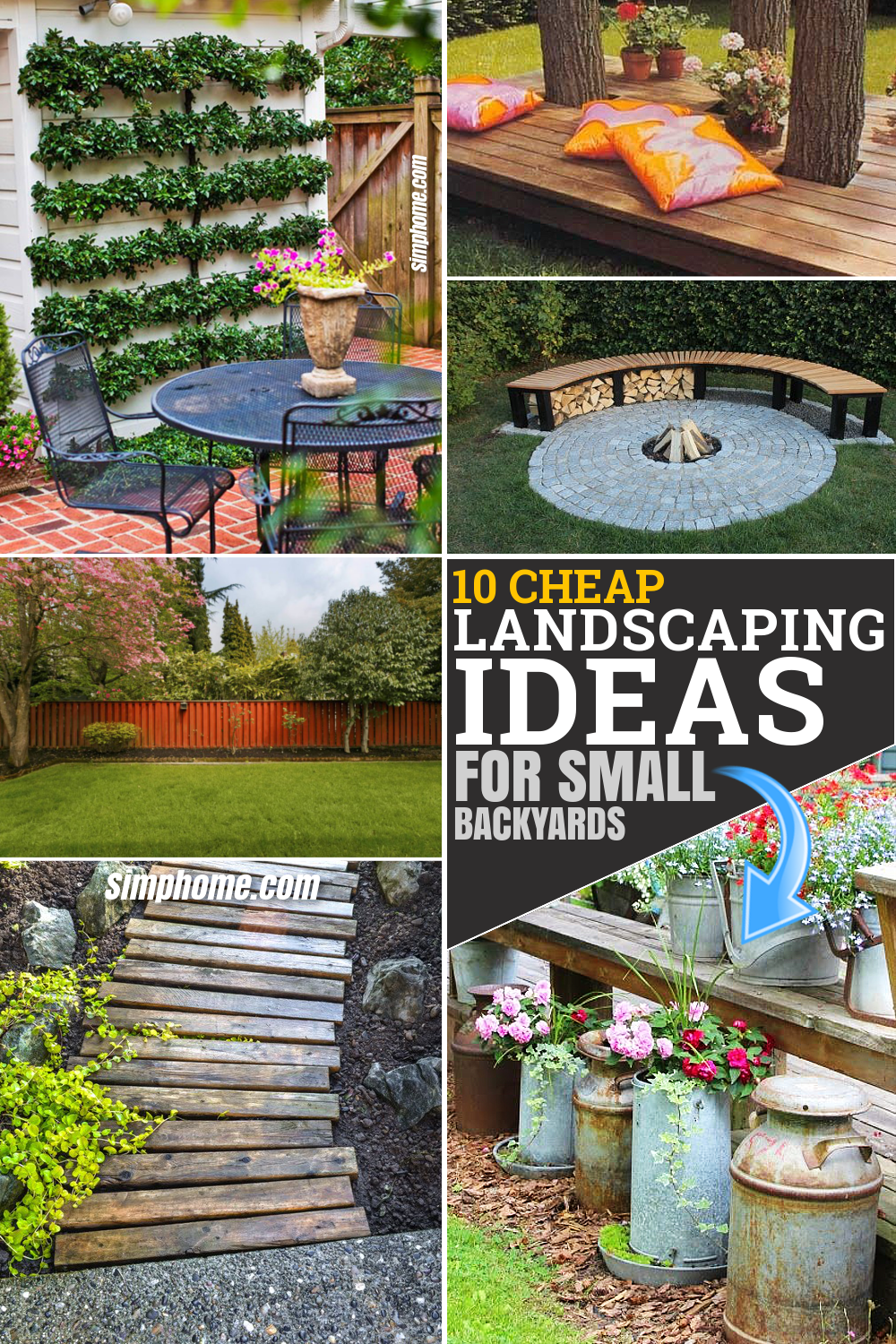
And the cool thing is the list is completed with the following video:
It’s a super relevant one; proof it and enjoy 🙂
Relevant Details and Information: Design Ideas ideal for a Small Backyard
An idea for a small backyard in this scenario could be to create a garden with vegetables. The vegetables would grow throughout the year, so there would be a constant supply of produce. In addition, it would also make it easier to grow food for livestock if they wanted to have one.
Option no 1. It might be difficult to find a spot for a vegetable garden, but it’s probably possible if you’re creative. You can get the idea of a small vegetable garden from your neighbor’s yard. You don’t have to go overboard when amending the look and theme of your backyard. All you need is to create a space with vegetables around your home with just enough room for these vegetable gardens.
Type of Vegetable for your gardens that you can select such as:
- Beans
- Potatoes
- Lettuce and other greens
- Chard and other edible greens
- Garlic and onions
- Tomatoes
- Peppers
- Strawberries
- Rutabaga (swede)
- Carrots, parsnips, celery root, and other root vegetables
- Brussels sprouts and other cauliflower-like vegetables like broccoli or cabbage that mature in early fall (transplants for these are usually available from nurseries)
- Summer squash and pumpkins
Option no 2: It’s rather easy to create a small garden that would meet your needs, and you can achieve this by simply planting flowers in your backyard. You could start by growing plants that are generally attractive to look at.
Flowers you can choose such as:
- Gardenias
- Roses
- Lavender
- Geraniums
- Marigolds and other colors of flowers like orange, yellow, and pink
- Thyme, sage, and other herbs
- Celosia floribunda (aka Zinnia) for a small garden [Optional]
- Garden mums
- Cosmos
- Sunflower
- Parsley
- Cosmos for a small garden (optional)
- Provence or Greek columbine (also called ‘paw paw’) for your small garden
Option no 3: You could plant shrubs in your small yard to make it look nice and decorative. It’s possible to build an edible garden, but you will need a lot of space for this, and it would be better if you made your edible garden have some extra space to relax and enjoy the fresh air and natural surroundings of the garden. Don’t forget to surround your small backyard with colorful flowers.
Shrubs you can choose such as:
- Potentilla
- Honeysuckle
- Hawthorn
- Black currant or Ribes (Highly recommended)
- Euonymus “Emerald Gaiety” or Coral Sunset, Emerald Carpet, Goldflame, Emerald Pincushion [Optional]
- Boxwoods and other small evergreens [Optional]
- Daphne odora [Optional]
- Pachysandra
- Japanese Holly or Prunus caucasica
- Lonicera ‘Blue.’
- Acer ‘Snowdrift’ and other evergreens [Optional]
- Ginkgo biloba [Optional]
- Olea Europea (aka European Ash) [Optional] [Not too big, or it will ruin the landscape of the garden.]
- Cornus canadensis and other shrubs [Optional]
- Viburnum opulus [Optional]
- Beech or Fagus sylvatica
- Forsythia x intermedia ‘Goldtau’ or White Splendor (White forsythia) [Optional]
- Cotinus coggygria ‘Grace’ [Optional]
- Halesia carolina ‘Silver Bell’ or Silverbell Tree [Optional]
- Acer buergerianum ‘Fastigiata’ or
- Carpinus betulus ‘Silver Queen’ [Optional]
- Lonicera sempervirens ‘Grace’ (Shrub Red Sawtooth) [Not too big, or it will ruin the garden’s landscape.]
- Acer cappadocicum (aka Cappadocian Maple) [Not too big, or it will ruin the garden’s landscape.]
- Berberis thunbergii ‘Atropurpurea’ or Purple Barberry (Bush Barberry) [Optional]
- Photinia (aka Cherry Laurel) [Not too big, or it will ruin the garden’s landscape.]
- Rhododendron “Catawbiense,” Great Laurel, or Rhododendron maximum (aka Rhododendron maximum “Catawbiense” [Also known as Cherokee Rose] [Optional]
- Viburnum plicatum ‘Mariesii’ (aka Viburnum plicatum “Mariesii” [Also known as Japanese snowball bush or Japanese snowball viburnum] [Optional]
Option no 4: You could also create an attractive garden that is attractive to look at, edible, and give you extra space for relaxing by simply using flowers that are generally attractive to look at and plants that are easy to grow.
Nutritious and attractive or edible plants you can choose such:
- Orchids
- Ivy
- Fig
- Currant and Ribes (Recommended)
- Vine plants such as ivy, wisteria, honeysuckle, cleome, or clematis (Recommended)
- Mulberry (Recommended)
- Fuchsia (Recommended)
- Rose (Recommended)
- Fruit trees such as apples, pears, peaches, and cherries (Recommended)
- Citrus trees such as orange, lemon, grapefruit, and tangerine [Optional]
- Fennel [Optional]
- Lettuce and other greens [Optional]
- Chinese cabbage (Also known as Oriental mustard or Chinese kale) [Optional]
- Parsley and other herbs [Optional]
- Bellflowers if you have a small garden (Recommended)
- Daffodils [Optional]
- Hyacinths [Optional]
- Dahlias and other florists’ or perennial flowers such as rhododendrons, medlars, winter Acer, maples, etc. [Recommended]
- Mints (Recommended)
- Herbs like parsley, mint, and thyme [Optional]
- Carrot family plants like celery, parsnip, and carrot [Optional]
- Berries such as blueberry, raspberry, strawberry, blackberry, and cranberry (Recommended)
- Malus (Recommended for the small backyard)
- Chives [Optional]
- Chervil [Optional]
- Other vegetables like tomato, lettuce, pepper, spinach, beans, cucumber, radish, spinach, and other small edibles that are easy to grow
- Fruit trees such as apples: If you have a small backyard or a garden but want to add fruit trees to it until you can add more.
- Pomegranate (Recommended)
- Plum [Optional]
- Fruit bushes such as raspberry and blackberry (Recommended)
- Beans in vines
- Small edibles that are easy to grow (such as beans) [Optional]
- Cucumbers and gourds [Optional]
- Peas (Recommended)
- Mint, parsley, cilantro, and other herbs [Optional]
- Radish (Recommended)
Another idea you can use is to create a “fountain” garden; it’s good to have water features or fountains in your backyard. This would make the area look more colorful and attractive because you can add flowers, shrubs, and trees around the fountain, and this would also give visitors a more enjoyable experience.
Growing Plants in Your Backyard
Step by step to growing healthy plants in the backyard for cheap:
Step 1: Design a landscape plan
It’s easier for you to start with a design for your backyard before you start planting anything. It’s good to use software or app to help you design your landscape like countless options you can find in the Apple Store or Google Play. You can also sketch it, draw it using computer software like Microsoft Paint or Adobe Photoshop (using layers), and print it out as a poster. Or using your trusty paper and sketching skill or crude drawing talent.
Step 2: Where to plant?
You have a rough plan for your backyard, and now you need to study your backyard’s soil and drainage system. Is it sandy? Clayey? How much sunlight does it get? This is a great starting point for understanding what grows best there. Also, pay attention to the location of your home. The location of your home plays a big role in how much sunlight it gets and the kind of soil and drainage it has.
Step 3: Planting the right plants
Now that you understand the current state of your backyard, you are ready to plant anything that will look good in the current state. The first thing to do is research plants online or at home (or both). Return to the previous section to find your healthy and hefty options
Step 4: Find out what it takes to grow healthier plants in a backyard
Go on the internet or through books like “Guide to Growing Healthier Plants” or “How To Grow The Healthiest Vegetables in Your Backyard.” A website like Gardeners.com is also a good resource for this information. You can also visit gardening forums online that offer lists of the easiest and most nutritious plants you can grow in your backyard or simply talk with gardening friends about growing healthy foods to eat.
Step 5: Plant healthy plants
Ensure to take care of the planting process to ensure it grows and survives without problems. You might need soil supplements, special composts, seed-starting supplies, etc. Find out how much it will cost so you know if it’s worth the investment.
Step 6: Keep an eye on your plants so you know when they are ready for harvesting
There are two seasons in gardening: the growing season and the harvesting season (or fall).
Daylight Codes (Typical Areas):
- North-east–bright sunshine or full shade from direct sunlight in summer when facing north.
- East-south-east–Bright sunshine or full shade from direct sunlight in summer when facing east.
- West-south-west–bright sunshine or full shade from direct sunlight in summer when facing west.
- North-west–full shade
- North northeast–part sun on the warmest side.
- Northwest–often part sun; winter usually gets the first Sun, and sunny hours eventually follow.
- South southwest (full sun) strongest sunlight occurs around mid-morning and early afternoon and often has hot sunny exposures; diurnal variation in midday is small to moderate.
- Southwest–strongest sunlight occurs in mid-afternoon to early evening.
- Southeast–summer hours in wintertime are usually sunny and getting warmer, with shorter mild days in the middle of the day and longer mild nights.
- Southeast–the sunniest side is the warmest side, which has more rain.
- Southeast–coldest month (December)
- Southwest–light precipitation falls mainly in winter, though some are during summer; Gulf Breeze, FL has a different climate than Phoenix and Tucson, AZ, and many other places with similar climates.
Step 7: Harvest your healthy plants
- You can harvest your plants anytime; fresh produce is best eaten that day.
- You can also freeze those that do not look perfect, like zucchini and peppers, onion sets, etc.
- Dry your orange-skinned and green zucchini in a paper bag, or brown-skinned ones, you should just throw them away because they are not eatable.
Important information you should seriously pay attention to when planting your healthy plants: - White Phosphorous is used in fertilizers, weed killers, and deodorants. Therefore, you must ensure you don’t use any products because they will kill your plants and poison you.
- Do not plant toxic plants in your garden; now, it is important to research the plants a few times before planting them to know what to expect from them.
- You should apply phosphorus fertilizer according to the label directions every three months or as directed by the manufacturer for best results or prompted by noticeable growth changes in the plant.
- You can use a high-quality liquid fertilizer (such as ones that contains organic matter, micronutrients, and some slow release of nutrients over a while) to help maintain healthy and productive plants.
- Ants are attracted to the color yellow, so if you put tissue paper or straws with yellow color, they will attract them and leave your plants alone. It is recommended to use a spray bottle filled with white vinegar; spray the infected areas to get rid of them.
- If your plants come in plastic pots or cell packs, you can transfer them into larger containers such as terra cotta pots or sturdy nursery containers so they can grow without problems.
- Avoid using weed killers or similar products on the soil around them.
- If you have problems with pests, you should use pesticides to control them.
- Leaves and berries produce lots of nitrogen in the soil and release it into the air for as long as the plants are alive. So do not compost any leaves or berries because it will release nitrogen into the air that way. You can easily see how much they put on a plant by looking at its size; if its leaves or berries are big, then that means that it was able to give nutrients to your plants.
- Don’t forget to water your plants; if they are not getting a lot of water, they will die.
- If you have dying tomatoes, you should fertilize them with burnt bone, charcoal, and lime to help them grow faster.
- However, it is best to plant them in soil enriched with lots of things because they need the nutrients to help them grow faster and healthier than normal plants.
- You can use two methods for planting tomatoes to ensure that everything goes well: organic or chemical-free methods.
- Planting with plastic mulch can help give plants more nutrients; it will keep them warm, reduce moisture loss from evaporation, conserve soil moisture, prevent weed growth, and deter insect pests.
- You can use a different approach than seeds; you can take a stem or a cutting from an existing plant and plant it into the soil to help you get new plants.
- Ensure your soil is not too hard to ensure your new plant grows healthy and fast.
- To keep your fresh harvest longer, use a damp paper towel to wrap them up before putting them into the refrigerator.
- You can use a vacuum or a pot of water with ice cubes to keep your plants fresh and moist because they will be able to keep a lot of moisture inside them.
- Keep your garden weed-free because if you don’t, weeds will grow in your garden; to ensure that no weeds are growing in your garden, you should go out and remove them before they grow in your plants.
- You can use straws or newspapers to wrap around the branches of plants when they are young and flexible enough to bend over and cover them easily. You can also use the paper to direct water into particular areas of the plant so that you will know where it is going.
- You should easily plant a tomato in an eggshell to grow into the soil easier later.
- If you want to plant geraniums, make sure you do it in the spring or summer; you cannot plant these plants during the wintertime because they need light and heat to help them grow fast and healthy.
- It is best to plant marigolds around or in your garden to help prevent pests such as whitefly, nematodes, and soil-borne diseases.
Step 8: Enjoy the fruits of your labor when you cook them or eat them in salads
To keep your salads safe to consume and remain healthy for your metabolism, you need to:
- Ensure that you wash your vegetables thoroughly because some of them might have chemicals, pesticides, and dirt that you should get rid of.
- You should also make sure to remove any damaged leaves or other debris.
- Make sure your lettuce is fresh and not brown or browning because if it is, you need to discard it as soon as possible since it can make you sick if eaten.
- To make salads healthier, you can add cauliflower florets because the chemical in them that helps fight against lung cancer and stomach cancer are extremely helpful in preventing these cancers from occurring.
- You can also use other vegetables, fruits, and nuts to make your salads healthier.
- You can use different types of lettuce, such as romaine or green leaf, to make your salads more colorful and appealing.
- You should use an organic salad dressing because it is better than conventional dressings available today because the organic ones don’t have harmful chemicals that might not be good for your health in the long run.
- To ensure that your salad tastes great, add a bit of salt and pepper to taste better and appeal more to the taste buds.
- You should also make sure not to dress your salads until right before they are eaten because if you do, the dressing will soak into the leaves and make them bland when eating them.
- If you want to ensure that your salad is fresh for as long as possible, you can use plastic wrap or aluminum foil around the lettuce heads to stay fresh for several weeks.
- If you want to make your salad more appealing and enjoyable, adding some mixed greens or baby greens is best.
- You should also add fresh strawberries, peaches, kiwis, apricots, or other fruit of the same season to make the salad more appealing and healthy.
- You can also use different types of cheese, such as feta cheese or goat cheese, in your salad to make it more appealing and attractive since both are great calcium and vitamin A sources for our body’s health.
- You will have more healthy eating choices if you use different types of protein, such as skinless chicken breast, tuna fish, beans, tofu, or organic eggs in your salads.
- You should make sure that you remove the lettuce leaves when you are done eating your salad to not get any rubbish on them or contaminate anything else they come in contact with and get all over everything.
- It is best to wear gloves when buying and preparing vegetables because these creatures might contaminate some of them with pests and insects. These pests can include worms, flies, ants, roaches, and other tiny creatures that can live in the dirt on the vegetables and contaminate them with their feces.
- You can also use Ziploc bags to keep your vegetables fresh; you can even get ones with oxygen absorbers so the vegetables will stay fresher for a longer time.
- You should always wash your hands thoroughly after handling any food because you never know if there might be small particles of dirt in your fingers, and when you eat it, you will infect yourself with bacteria or other harmful things to your body’s health.
- You should ensure that all vegetables have been washed thoroughly before cooking them because some still have traces of soil on them, which might be harmful to your health if eaten.
- You can also pick your vegetables before they are cooked to ensure that they are clean and fresh and not to get sick from eating something contaminated with pathogens.
- You should store your vegetables at 60 degrees Fahrenheit or less because if they are stored too high, it might increase the spoilage rate, and they will be damaged when stored at too high temperatures.
- It is best to store your vegetables for no more than 3 days before eating them because they will not spoil as quickly when stored longer than this time.
- You should also wash and dry your vegetables before storing them because some still have soil and other harmful substances.
- If you want to store your vegetable in the refrigerator, it is best to keep them in a plastic bag so that the vegetables will stay crisp and fresh longer.
- You should also ensure that the top shelf of your fridge is large enough to fit all of your vegetables if you want to keep them at the temperature of 60 degrees Fahrenheit or colder for as long as possible without letting them spoil completely.
- If you want to ensure that your vegetables stay fresh for as long as possible, you can use a humidifier in the room where they are stored; this will help keep the air moist so the vegetables will last longer.
- The best place to store your vegetables if you want them to last longer is in the basement because this is the coldest place in your house, and it is not as humid, so there is no moisture for bacteria and mold to grow on them.
- It is best to purchase a storage container for storing vegetables with lids on them because it will be easier to clean and help keep dust and debris out of your veggie food supply.
- You can also purchase a large-sized refrigerator with a full-sized freezer to have more storage room for your veggie food supply.
- If you want to store your vegetables in the freezer, it is best to make sure that you only put them in there once they are cooled since if they are frozen when still warm, they might melt when you thaw them out, and then the vegetables will not be able to be stored in the freezer at all.
- You should also ensure that all the vegetables are covered with ice cubes or frosted with water to stay fresher for much longer; this will help prevent spoiling.
- Since the colder it is outside, the longer your vegetables will keep in the freezer, it is best to store them in a not-as-hot place like a basement.
- It is always best to purchase locally grown vegetables because they are grown in low-mileage shipping containers, and they do not have to travel as far so that you can enjoy fresher and tastier food at all times.
- You should also ensure you wash your hands thoroughly before touching herbs or fruits so that you will not contaminate or spread bacteria on your plants with harmful substances and microorganisms.
- When preparing your vegetables, it is best to have a separate cutting board and a knife used only for fruits and vegetables to prevent bacteria and other organisms from spreading to your foods.
- You should also ensure that you clean the cutting board, knife, and other tools used to prepare your food with warm water to wash away any bacteria; this will help wash away harmful substances and help sanitize the items.
- The most effective way to cut fruits and vegetables into pieces or slices is by using a sharp chef’s knife because it will make the process go smoother without wasting time or effort on prepping them for eating later.
- You should also make sure that you use the freshest produce with the most nutrients so that you will be able to enjoy the full benefits of these foods.
- The best way to preserve foods is by canning them and freezing them for use in the future because this will prevent food spoilage before it happens.
- You should also ensure that you cook your vegetables at 400 degrees Fahrenheit or lower; otherwise, they might not be properly cooked and could become unhealthy for consumption later on when eaten. The same goes for deep-frying, but this preparation method is not recommended because it contains a lot of fat and calories that are very unhealthy to consume.
20 Gardening Tips for A Beginner
- Choose a sunny spot. If you can sit outside while you garden, that’s great, but if not, a south-facing patio with full sun exposure is the next best option.
- Find a garden bed that’s already in use. It doesn’t have to be huge—even a small section of someone else’s garden will work fine—but it should be free from debris and ready to work with. You can still build your compost pile at home or look for one near your school if you have one nearby.
- Get a large piece of plywood or ground cover and lay it over the area you plan to garden. These items will provide a sturdy place for your plants to grow and keep the soil from washing away if your water is in dry patches. In addition, if you want to add any kind of privacy, this will give you some nice walls to plant against.
- Decide what size garden bed—or window box—you want. How big are you going to be able to devote? A larger garden, which is situated toward the back of the property, might give you room for a vineyard or small vegetable patch; smaller gardens can get away with just a few plants.
- Dig out the soil that’s in the hole and throw it away. Fill up any remaining holes with soil and add a little compost to your mix if you use dirt.
- Plant seeds or trays of transplants over a while to give them time to learn and establish before adding other varieties.
- Choose plants that will be tough enough to survive in your garden zone, but if you’re not sure, consult your city’s gardening department for a list of what will grow in your area.
- Start watering your plants as soon as you plant them. If you’re impatient and have to wait a few days, add a little water each day if needed.
- Give each plant enough soil that it needs to thrive before adding any more. You don’t want the bottom of your plants to washing away!
- Build up the soil around the plants and add compost every couple of weeks or whenever needed.
- Mulch around your plants is good for one season; use your discretion on how tight you’ll need to weave it around each plant before planting the next.
- Keep a bag of compost and dirt around the house so you’ll have it when you need it most. You can also buy inexpensive grow bags to keep your plants in, but be sure to use them correctly, or they might not do any good.
- Don’t remove diseased plants immediately; just keep an eye on them and note the location so you can remove them later.
- If you’re still having trouble saving your plants, look for a nearby gardening center—even hardware stores sometimes have employees who are knowledgeable about different types of soils and composts, as well as helpful tips for growing in your area.
- If you have a small kid or a dog that likes to nibble on everything, consider using chicken wire to keep the smaller plants safe from potential predators.
- Be sure to space your plants enough so they won’t start growing together. If possible, give them an extra couple of inches of the room so they can flourish and grow big and strong.
- Don’t be afraid to let weeds take over—they’ll help cover up your dirt patches as you till through them when you’re weeding later on!
- Tie vines to your garden to keep them from falling over.
- Watering tips: Be sure to water everything simultaneously so that all the plants receive equal water. But if you don’t feel like getting up early in the morning, you can also try setting your watering can on a timer or using a sprinkler system so that it will come on at certain times throughout the day.
- If you’re planning to buy any type of fertilizer, bring it home and spread some around each plant so that they’ll get used to their new home and get used to their new environment in general; this will help them grow better in the long run.
No Man’s Land Garden: Notes on Rooftop Gardens
The no man’s land garden concept is fascinating as they provide us with the possibility of getting a piece of land for cultivation even in the city. We know that there are about 0.8 hectares of cultivable land in cities, yet only 5% is used by people, which means we are losing many potential food sources. At the same time, there is a lot of space on rooftops above all buildings that you can use for horticulture.
There are many advantages to rooftop gardens – they all originate from the fact that height does not matter when growing plants vertically.
More about rooftop garden benefits you’ll get:
- Benefit No 1. When you have your garden on a roof, you avoid soil-borne diseases.
- Benefit No 2. If you have limited time (either for work or just life in general), this is one of the best ways to have a garden, as it won’t require constant tending and watering, and you don’t need to do any weeding – as long as there are no animals around!
- Benefit No 3. Of course, you can mostly save energy because of the little space needed, and fertilizer consumption is very little because plants grow naturally without much intervention.
- Benefit No 4. When the days gets longer, light penetrates from above, which gives nutrients needed by the plant on the rooftop.
- Benefit No 5. If you want to make your garden pretty, no more worrying about arranging plants, as you can arrange them in any order you want.
- Benefit No 6. You will better view the sunrise and sunset from your rooftop garden.
- Benefit No 7. There is no need for artificial lighting when you have an outdoor kitchen on the rooftop because the sunrays provide plenty of light during the day. But if it gets too hot for your plants during summertime, installing artificial lights is always an option to keep your plants alive in that environment.
- Benefit No 8. If you have a small piece of land between you and your neighbor, you can use it for your garden. And best of all – no need to worry about a fence!
- Benefit No 9. If you have less space, there is no problem because vertical gardening can easily solve this – even in a city like New York with skyscrapers, plants grow in very limited space.
- Benefit No 10. Aside from being very practical, rooftop gardening also looks amazing in itself, with many different kinds of plants growing together and intertwining using each other as support.
However, outside of those benefits above, you’ll have to pay attention to the following:
- No 1. Check the intensity of sunlight with a light meter before planting anything so your plants can thrive in the right environment.
- No 2. Create a trellis or support structure for the plants on your rooftop garden so that they have something to climb on and grow around and protect them from strong winds.
- No 3. Ensure that your garden has no dangers like electrical wires or poles.
- No 4. Ensure to water your plants often, even if the weather is not hot, as the wind can dry them out quickly.
- No 5. Take care of pests and diseases so that you don’t have any diseases spreading among your plants.
- No 6. Take care of the air quality, as some plants have a very bad time in polluted areas, so if you are in an area where there is still a lot of air pollution, consider planting only certain types of plants (for example, strawberries).
- No 7. Get rid of invasive species, such as bindweed and wild parsnip.
- No 8. Make sure that your garden is accessible by emergency vehicles – but if you’re on the top floor, there shouldn’t be any problems because it’s easier to get to higher floors.
- No 9. Choose your plants carefully so that your garden will look nice and will be functional for you.
- No 10. Take care of the appearance of your garden, especially if you have guests.
Rooftop Garden For True Beginners
Designing a rooftop garden can be daunting for those who have never done it. And if you’re one of them, you may feel overwhelmed by how complicated it seems.
But like almost everything in life, there’s an easier way to do things and get familiar with them. The easiest way to learn how to design a rooftop garden is by taking small steps and learning from your mistakes along the way.
How do you Grow more plants & repeat it?
Answer: You need to fill your rooftop garden with plants of different varieties. It is a very hard task initially, but if you follow a few steps below and have patience, you’ll find yourself growing more and more plants in no time.
- Layout your garden area on your roof without pre-planted plants; this will give you an idea of how much space you need for them – getting rid of excess inventory is one way to save money while ensuring that your plants get enough sunlight.
- Do a little research on the plants you want to grow this year. Several websites provide free information for learning about plants and caring for them, such as the New York Botanical Garden and the Massachusetts Natural Heritage Program.
- Find out where you can get seeds or bulb starts for each plant from a local garden shop; some may not be able to help you but try your luck anyway and ask them if they have any seeds or bulbs left – they may be able to save them for you.
- Buy seeds and bulb starts from different plants; you may want to consider saving a little from each type of plant and learn what grows best in your garden first. You’ll have better luck growing more than one plant at a time instead of just one or two.
- Place your seeds or bulb starts on the soil’s surface and ensure that you keep them moist, even after the seeds have sprouted.
- Keep an eye out for pests, diseases, and other problems that may come up in your garden to avoid them before they get out of hand.
- Choose the most appropriate plants depending on the season of their growth; different types of plants require different temperatures and sunlight, so do some research and find out what grows best at your place.
- When you start laying your garden, ensure that you have good drainage for water to run off – try to place your plants so they’ll get enough sunlight and water.
- Get some chickens or birds to eliminate annoying insects such as bees and wasps. If you don’t want these pests, remove them from your garden by placing screens or netting over them.
- Gather all your seeds and bulb starts, water them and place them into a box with enough cushion to protect them from being knocked over or otherwise harmed, as well as keep moisture in.
- When you’re done planting your garden for the season, remove your plants and keep leftovers of the seedlings in a separate place so that you’ll have to plant again next year.
10. Spruce your Wall up
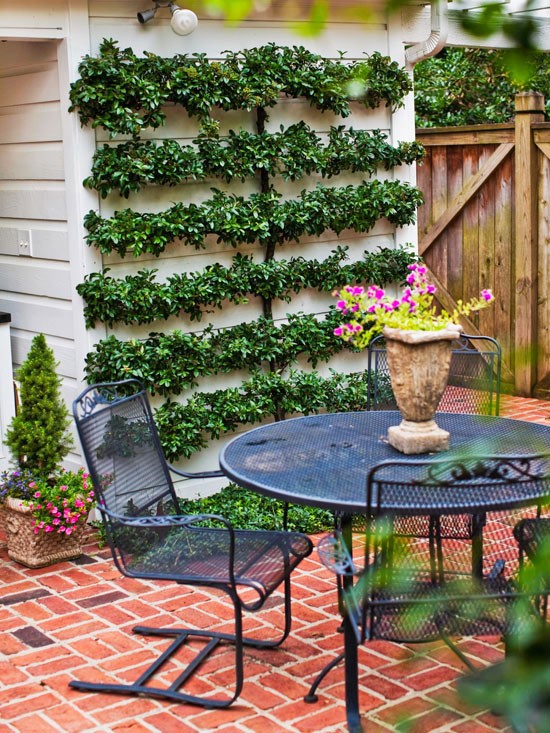
Decorating the backyard can be started by giving your wall a lively lift. If your wall looks a bit mundane and you feel you need to do something about it, then this idea might be what you’re looking for.
- First, attach some planters to the wall to host your favorite greenery. This is a great way to grow some plants, especially if you have limited space.
- Next, don’t forget to trim the plants regularly to tidy them.
- Try adding faux wood in the middle to copy the look of a tree. It may look challenging, but it’s quite easy to do it.
And if you live around Seattle and want to avoid unnecessary mishaps, you can consider planting trees in the backyard with Tree Service Seattle
9. Create a Pathway
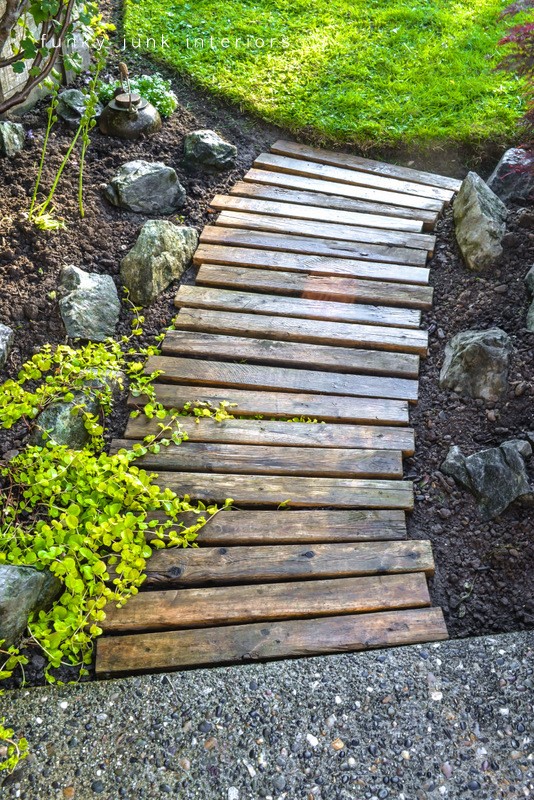 A pathway shouldn’t be taken for granted as it gives you a striking landscape and helps you leap or keeps your shoes free from mud.
A pathway shouldn’t be taken for granted as it gives you a striking landscape and helps you leap or keeps your shoes free from mud.
Since there are many pathway styles with various materials, choose the best pathway that fits the entire backyard landscape. A palette pathway would be a cheap and simple way that you can give a try to decorate your garden. Look no further! To follow this simple idea, you can just root around in your storage room for some leftovers.
8. Build a New Wooden Garden Fence
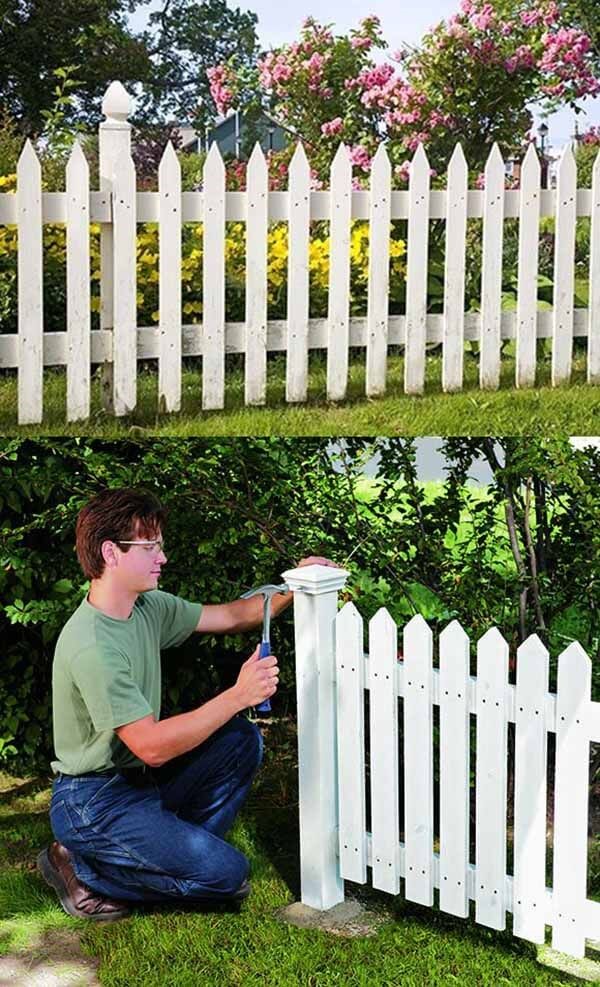 Building fences can be your greatest bet to keep your garden safe from unwanted intruders, including your neighbor’s dog that sneaks into it. It offers peace of mind when you’re not around, as the fences can hinder dogs and any other intruder from making a mess. It is also an effective way to divide areas in your backyard.
Building fences can be your greatest bet to keep your garden safe from unwanted intruders, including your neighbor’s dog that sneaks into it. It offers peace of mind when you’re not around, as the fences can hinder dogs and any other intruder from making a mess. It is also an effective way to divide areas in your backyard.
Besides, building fences can be a fun activity you should try, making your backyard look organized.
7. Smart Investment with Planting Trees idea
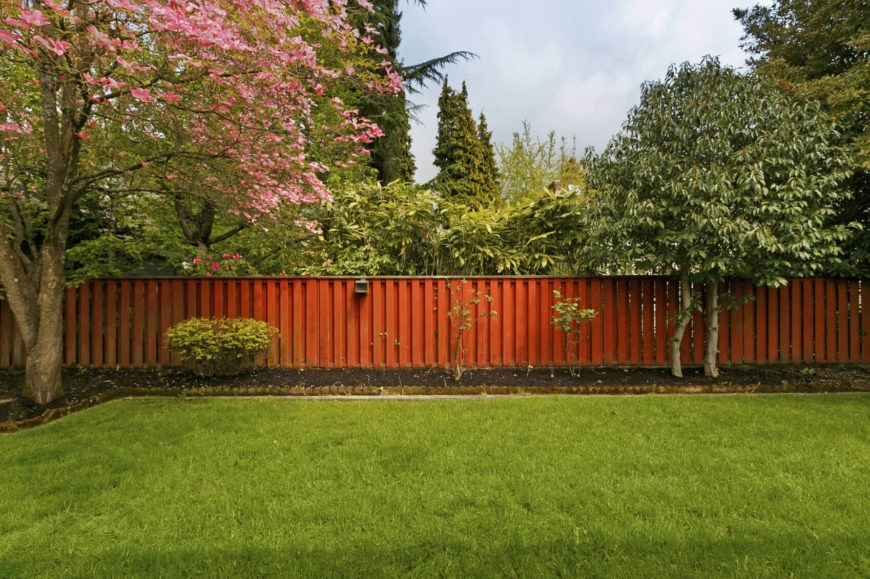 Trees are a vital element of nature that gives you many benefits, including fresh air, shade, and a cozy place to sit under. Depending on the trees you plant, they can also make your backyard look spectacular when their flowers start blooming.
Trees are a vital element of nature that gives you many benefits, including fresh air, shade, and a cozy place to sit under. Depending on the trees you plant, they can also make your backyard look spectacular when their flowers start blooming.
In the future, as the trees grow bigger and bigger, you will realize how essential it is to plant trees in the backyard. This is one of the many inexpensive ways to have a comfortable environment in your backyard.
It’s easy to follow as you just have to cultivate, dig, and plant.
Relevant ideas: 10 Beautiful Leather Plant Holders Worth Trying.
How to build an Awesome Tire Planter.
How to Build a DIY Corkboard + Planter.
6. Install a Fire Pit
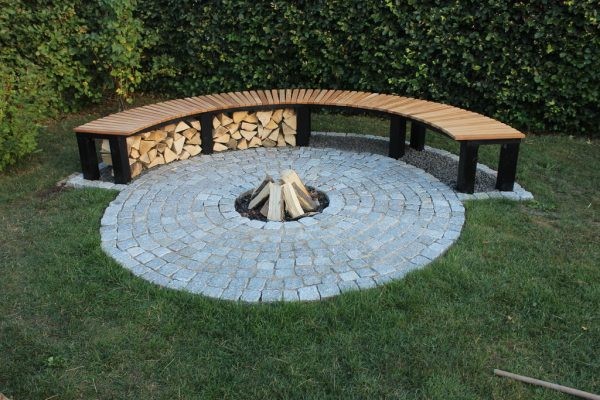
It feels incomplete if your backyard doesn’t include this spectacular, neighbor-friendly feature. You who love hosting a small party can’t go wrong with installing a fire pit. It’s an accessory that makes a great landscaping idea for sure. Besides, it won’t gobble up the limited space in your tiny backyard.
5. Light your Night
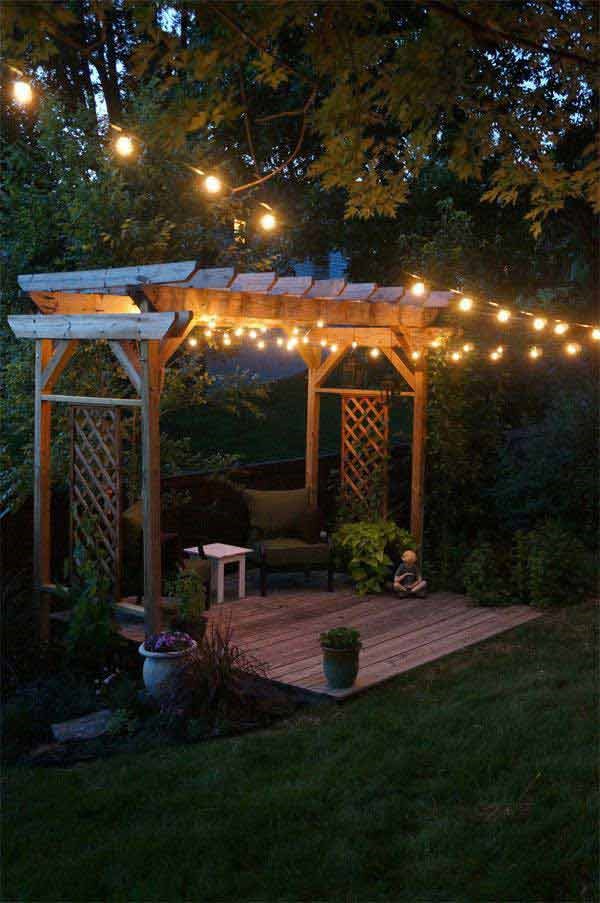 When the night comes, and you feel that it’s too dark outside, you can install string lights to give your backyard a nice warm light. This can be an affordable way to give your patio a romantic ambiance. Or, you can try to insert some battery-powered LED fairy string lights into some mason jars and hang them from your patio cover.
When the night comes, and you feel that it’s too dark outside, you can install string lights to give your backyard a nice warm light. This can be an affordable way to give your patio a romantic ambiance. Or, you can try to insert some battery-powered LED fairy string lights into some mason jars and hang them from your patio cover.
They light your backyard up and make you love to hang around the patio when you just want to chill out at night. You don’t have to surround the backyard with string lights because it would get too bright and make your electricity bill spike.
4. A DIY Wooden Seating Idea
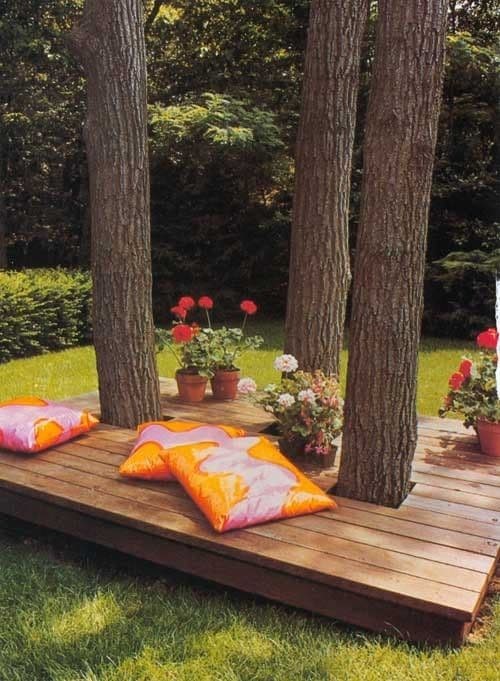 A floating deck can be the best add-on that needs to be incorporated into your backyard. It offers a perfect place for outdoor gatherings. Making this floating deck is not that hard. You will need to set concrete blocks on gravel and ensure they are level. Then, install and square the beams by taking diagonal measurements and tapping one beam forward or back.
A floating deck can be the best add-on that needs to be incorporated into your backyard. It offers a perfect place for outdoor gatherings. Making this floating deck is not that hard. You will need to set concrete blocks on gravel and ensure they are level. Then, install and square the beams by taking diagonal measurements and tapping one beam forward or back.
After that, screw on the brackets that will hold the joists. Then, install the middle and end joists, and don’t forget to screw on the rim joists. Next, add the corner blocking and steps; after that, you can attach the decking. You can try attaching it using hidden fasteners to create a cleaner look.
Once the decking has been attached to the joists, it’s time for you to skirt the board to conceal the unwanted look and finish the steps.
3. Decorate your backyard Corner
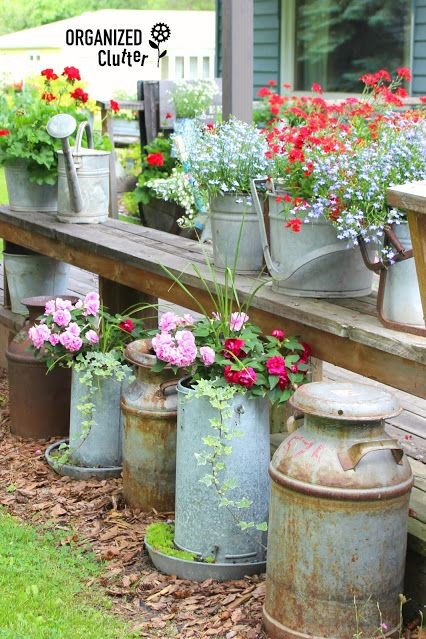 The corner of your backyard can be colored with different beautiful flowers using some unused stuff such as chicken feeders, milk cans, and mop buckets. You can as well make good use of other similar objects in your house if you don’t have any of these.
The corner of your backyard can be colored with different beautiful flowers using some unused stuff such as chicken feeders, milk cans, and mop buckets. You can as well make good use of other similar objects in your house if you don’t have any of these.
Look how pretty this landscaping idea is! The corner that once was neglected now became a place people hardly turn their heads off. Landscaping is not always about how fancy things you buy to decorate it; instead, it’s a matter of how creative you can be.
How to Putting Flowers Around the Yard?
Answer: If you’re wondering why you should even care about putting flowers around your yard, here are just some of the reasons:
- Benefit No 1. Flowers around your yard can be aesthetically pleasing and encourage people to stay in your home longer; they’ll act as an anchor for the eyes when they enter a room.
- Benefit No 2. Depending on the flower you choose to plant in your front garden, you may be able to attract certain species of birds or butterflies flocking to them – this will give a whole new meaning to attracting wildlife into your homes, such as bees and other insects.
- Benefit No 3. Flowers can be used to repaint your home’s walls or give your house a new look by adding a touch of greenery to them.
- Benefit No 4. Flowers around your yard can attract butterflies and other insects; this will improve air quality in your home by making it more fragrant.
- Benefit No 5. You can create your hydroponic garden mostly for vegetables and herbs, and eventually, you may have to start using only flowers for other purposes, such as flavorings, perfumes, and cosmetics.
10 Steps To grow healthy flowers around your yard:
- Step 1: Choose the right flower for your yard to make it more attractive – you can have a bigger chance of attracting birds and insects if you plant the right type of flowers in your front garden.
- Step 2: Make sure that the flowers you’re growing are native to your area; they’ll survive easily without any problems, saving you from unnecessary care required for them.
- Step 3: Soil is an essential part of any gardening project; it’s important to choose the right soil that will be able to support the growth of flowers and other plants in your yard. It should be light enough but retain moisture so it doesn’t dry out too quickly.
- Step 4: Ensure that you have a good drainage system for excess water to flow through and away from your flowers – you may want to consider using the right irrigation system or even digging a pit.
- Step 5: Make sure that your flower bed is in the right place; depending on the type of flower that you’re growing, it may be best to grow them near things such as walls or fences and avoid areas where they’ll be too much stress from things like wind or water.
- Step 6: You can easily create your fertilizer for flowers by putting them in a box with some soil and adding just a few drops of liquid fish fertilizer; this will encourage rapid growth and proper development of flowers.
- Step 7: Trim your flowers regularly to avoid any damage from too much stress on their stems or leaves – this will help them grow in the right direction and keep them clean from any foreign bodies that may affect the quality of your air.
- Step 8: If you’re planting your flowers in the winter, ensure that you’re planting them in a place that receives at least six hours of sunlight.
- Step 9: Various flowers are biodegradable, just like those non-biodegradable – you can use these when the air inside your home becomes more than desired. It will give an aesthetic appeal to your lawn or yard by putting out attractive colored blooms.
- Step 10: When you’re planning on transplanting a new kind of flower into your yard, ensure it’s done with care to not cause any damage to other plants around it or even the soil underneath it.
2. DIY Tires Pond idea
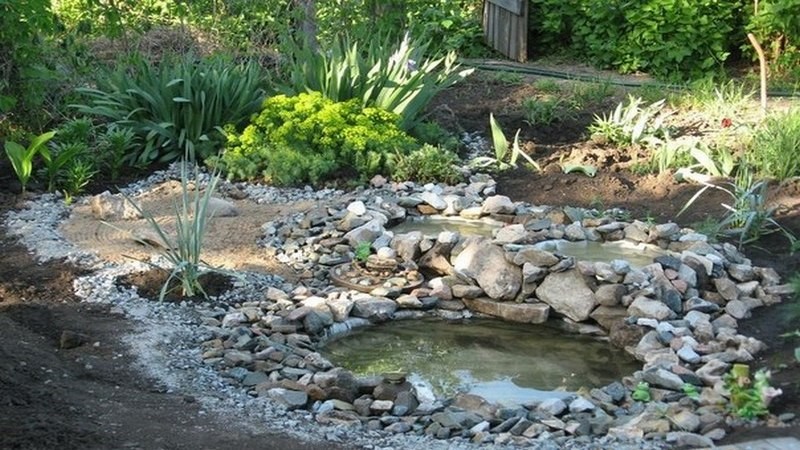 You wouldn’t believe these beautiful ponds are made of old tires. Yes, if you feel like creating a pond to make the garden looks more than just attractive, you can apply it to your backyard landscaping idea.
You wouldn’t believe these beautiful ponds are made of old tires. Yes, if you feel like creating a pond to make the garden looks more than just attractive, you can apply it to your backyard landscaping idea.
It can make the garden feel so special with ponds in it. It’s like you have oases that would attract animals to it. Even people or your neighbors would love to see and would love to know how to construct them.
You might want to decide first where the ideal spot is before digging. Make sure this additional notion can elevate your garden and not just something that makes it too much. Then, you can cover the recycled tires before pouring water into them.
Lastly, number 1. Enrich your backyard with Plants edging
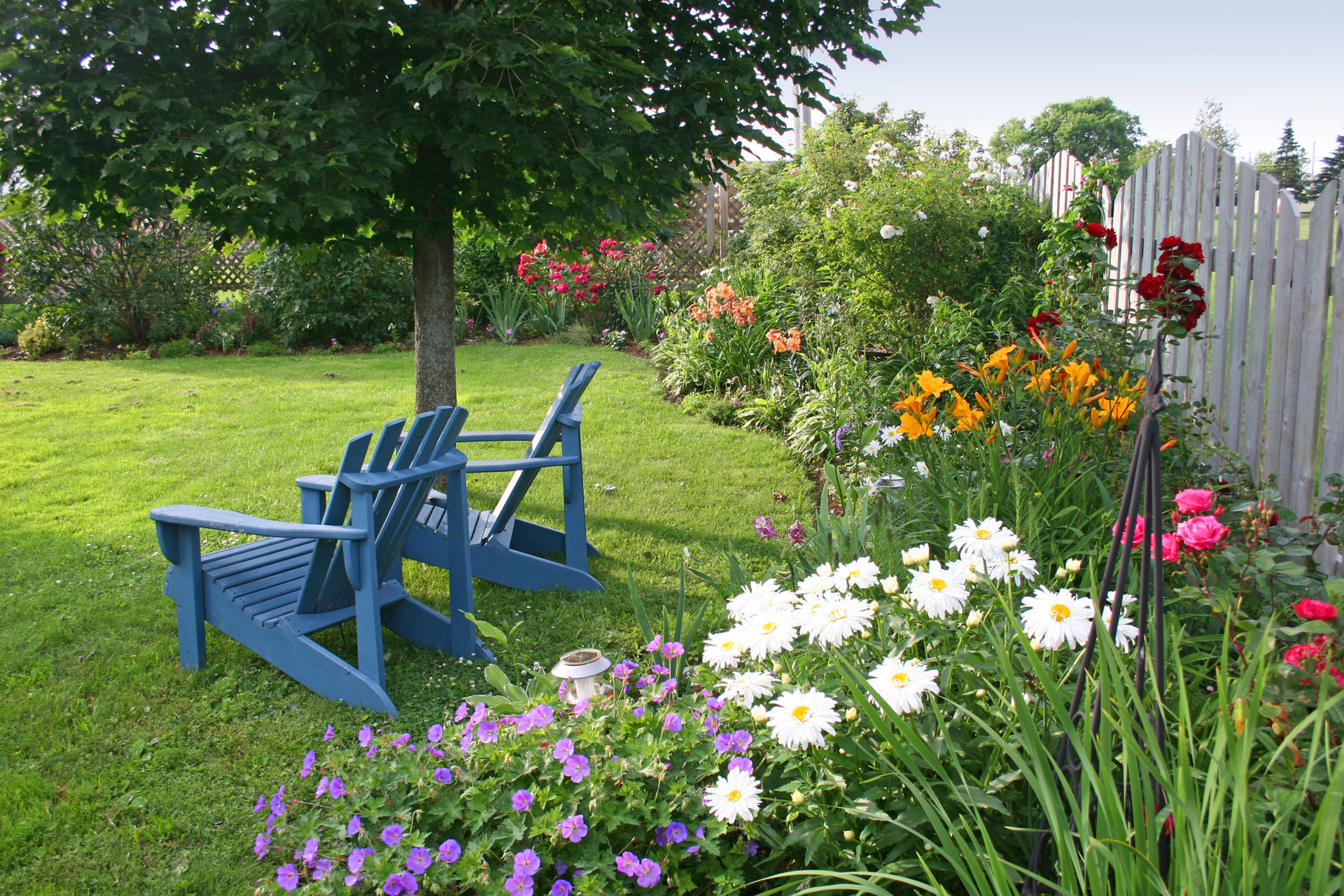 Lastly, the backyard would be much more comfortable with beautiful plants and flowers. Planting some vegetables and herbs should also be included, as they will give you plenty of benefits in the long run.
Lastly, the backyard would be much more comfortable with beautiful plants and flowers. Planting some vegetables and herbs should also be included, as they will give you plenty of benefits in the long run.
It would be much healthier to consume your own veggies that you plant yourself in the backyard than buy some from the grocery stores, right? From these colorful flowers, you can also tell that you have a wonderful small garden that becomes the center of attention.
Another list Related to this compilation: 10 DIY Flower Garden Ideas and Containers.
10 Small Home Garden Makeover ideas.
So Those are cheap landscaping ideas for small backyards you can adopt and improvise to match the landscape of your backyard. I hope you like it and see you later with more home improvement ideas.
Credits:
10. Spruce the Wall up | BHG.
9. Create a Pathway | Funky Junk Interiors.
8. Build a Fence | Home BNC.
7. Smart Investment with Planting Trees | Home Stratosphere.
6. Install a Fire Pit | Morning Chores.
5. Light the Night | Homesthetics.
4. DIY Seating Idea | Yard Surfer | Family Handyman.
3. Decorate the Corner | Country Living.
2. DIY Tires Pond | The Owner Builder Network.
1. Enrich It with Plants | Sherwood Foresthoa.